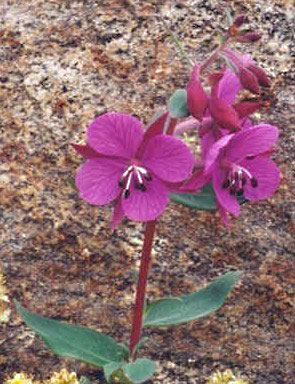
Convolvulaceae, commonly called the bindweeds or morning glories, is a family of about 60 genera and more than 1,650 species. These species are primarily herbaceous vines, but also include trees, shrubs and herbs. The tubers of several species are edible, the best known of which is the sweet potato.

Apidae is the largest family within the superfamily Apoidea, containing at least 5700 species of bees. The family includes some of the most commonly seen bees, including bumblebees and honey bees, but also includes stingless bees, carpenter bees, orchid bees, cuckoo bees, and a number of other less widely known groups. Many are valuable pollinators in natural habitats and for agricultural crops.

Megachilidae is a cosmopolitan family of mostly solitary bees. Characteristic traits of this family are the restriction of their pollen-carrying structure to the ventral surface of the abdomen, and their typically elongated labrum. Megachilid genera are most commonly known as mason bees and leafcutter bees, reflecting the materials from which they build their nest cells ; a few collect plant or animal hairs and fibers, and are called carder bees, while others use plant resins in nest construction and are correspondingly called resin bees. All species feed on nectar and pollen, but a few are kleptoparasites, feeding on pollen collected by other megachilid bees. Parasitic species do not possess scopae. The motion of Megachilidae in the reproductive structures of flowers is energetic and swimming-like; this agitation releases large amounts of pollen.

Halictidae is the second-largest family of bees with nearly 4,500 species. They are commonly called sweat bees, as they are often attracted to perspiration. Halictid species are an extremely diverse group that can vary greatly in appearance. These bees occur all over the world and are found on every continent except Antarctica. Usually dark-colored and often metallic, halictids are found in various sizes, colors and patterns. Several species are all or partly green and a few are red, purple, or blue. A number of them have yellow markings, especially the males, which commonly have yellow faces, a pattern widespread among the various families of bees. The family is one of many with short tongues and is best distinguished by the arcuate basal vein found on the wing. Females in this family tend to be larger than the males. They are the group for which the term 'eusocial' was first coined by entomologist, Suzanne Batra.

Plantaginaceae, the plantain family, is a large, diverse family of flowering plants in the order Lamiales that includes common flowers such as snapdragon and foxglove. It is unrelated to the banana-like fruit also called "plantain." In older classifications, Plantaginaceae was the only family of the order Plantaginales, but numerous phylogenetic studies, summarized by the Angiosperm Phylogeny Group, have demonstrated that this taxon should be included within Lamiales.

The Onagraceae are a family of flowering plants known as the willowherb family or evening primrose family. They include about 650 species of herbs, shrubs, and trees in 17 genera. The family is widespread, occurring on every continent from boreal to tropical regions.

Monarda is a genus of flowering plants in the mint family, Lamiaceae. The genus is endemic to North America. Common names include bergamot, bee balm, horsemint, and oswego tea, the first being inspired by the fragrance of the leaves, which is reminiscent of bergamot orange. The genus was named for the Spanish botanist Nicolás Monardes, who wrote a book in 1574 describing plants of the New World.

Nyctaginaceae, the four o'clock family, is a family of around 33 genera and 290 species of flowering plants, widely distributed in tropical and subtropical regions, with a few representatives in temperate regions. The family has a distinctive fruit type called an accessory fruit or anthocarp, and many genera have extremely large pollen grains.

The Colletidae are a family of bees, and are often referred to collectively as plasterer bees or polyester bees, due to the method of smoothing the walls of their nest cells with secretions applied with their mouthparts; these secretions dry into a cellophane-like lining. The five subfamilies, 54 genera, and over 2000 species are all evidently solitary, though many nest in aggregations. Two of the subfamilies, Euryglossinae and Hylaeinae, lack the external pollen-carrying apparatus that otherwise characterizes most bees, and instead carry the pollen in their crops. These groups, and most genera in this family, have liquid or semiliquid pollen masses on which the larvae develop.

The Labeninae is a subfamily within the parasitoid wasp family Ichneumonidae. The family is divided into 12 extant genera grouped within four tribes.

Panurgini is a tribe of bees in the family Andrenidae. There are about 9 genera and more than 830 described species in Panurgini.

Attagenini is a tribe of carpet beetles in the family Dermestidae. There are at least 4 genera and 20 described species in Attagenini. Attagenini was previously considered a subfamily of Dermestidae called Attageninae, but was reduced in rank to tribe in 2003.

Hoplitis is a genus of bees in the family Megachilidae. There are more than 380 described species in Hoplitis.

Rophitinae is a subfamily of sweat bees in the family Halictidae. There are about 13 genera and more than 260 described species in Rophitinae.

Brachynomadini is a tribe of cuckoo bees in the family Apidae. There are at least 5 genera and 20 described species in Brachynomadini.
Dearthrus is a genus of carpet beetles in the family Dermestidae local to North America. There are at least two described species in Dearthrus.

Arcynopterygini is a tribe of springflies in the family Perlodidae. There are about 11 genera and more than 30 described species in Arcynopterygini.

Paranomada is a genus of cuckoo bees in the family Apidae. There are at least three described species in Paranomada.

Augochloropsis is a genus of brilliant metallic, often blue-green, sweat bees in the family Halictidae. There are at least 140 described species in Augochloropsis.

Dioxyini is a tribe of cuckoo bees in the family Megachilidae. There are eight genera in Dioxyini, comprising 36 species.



















